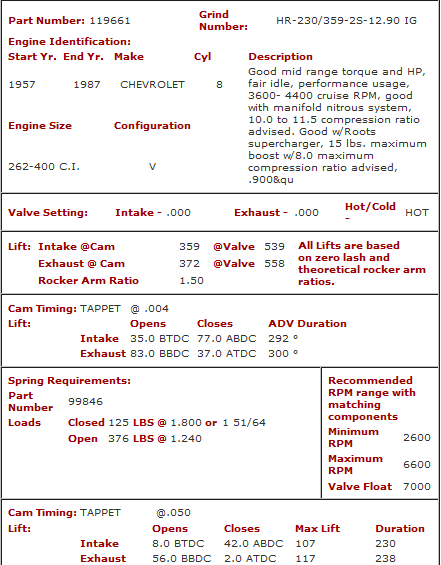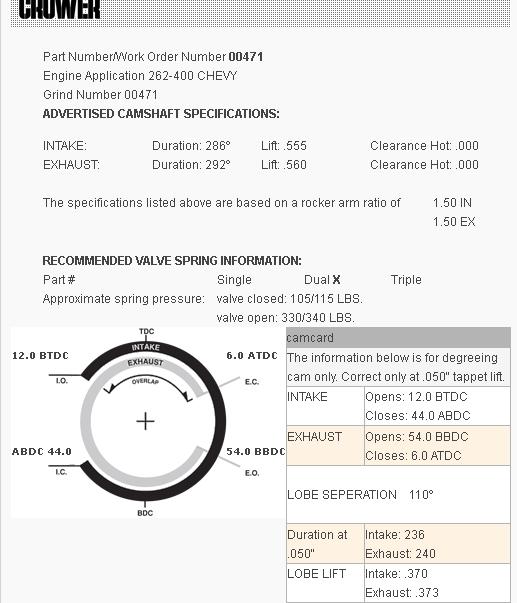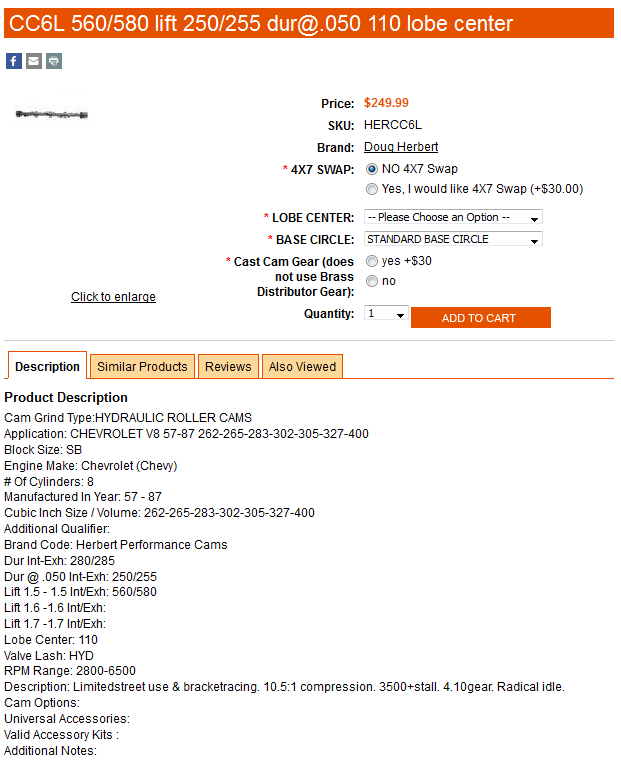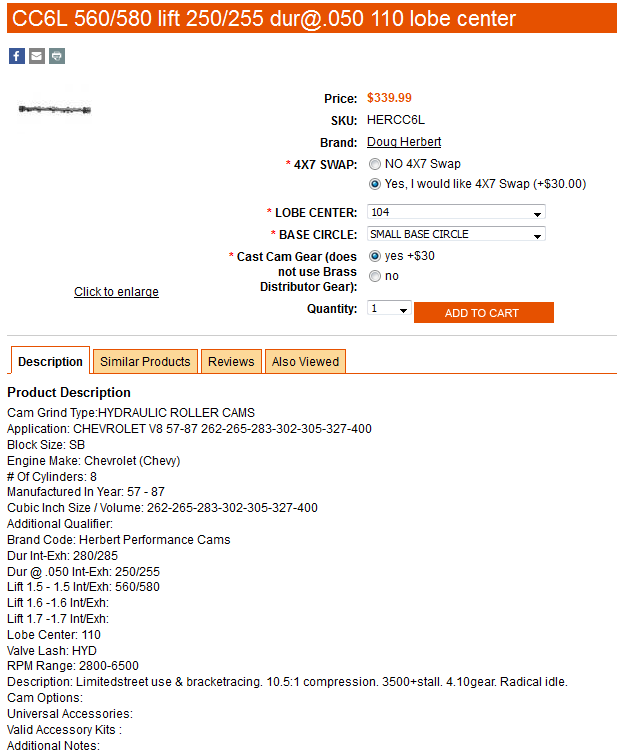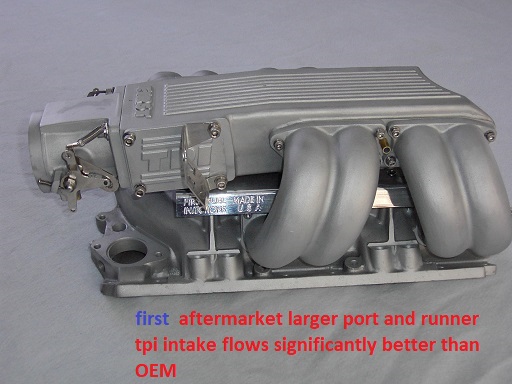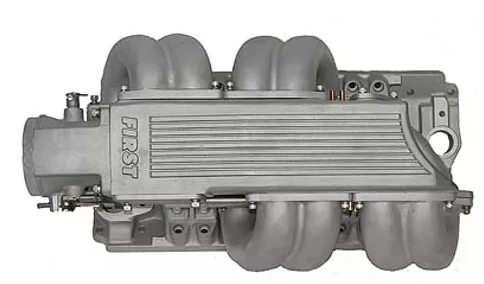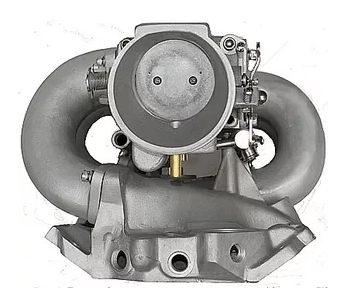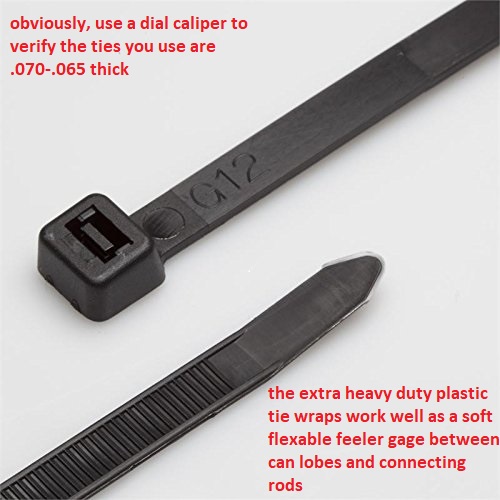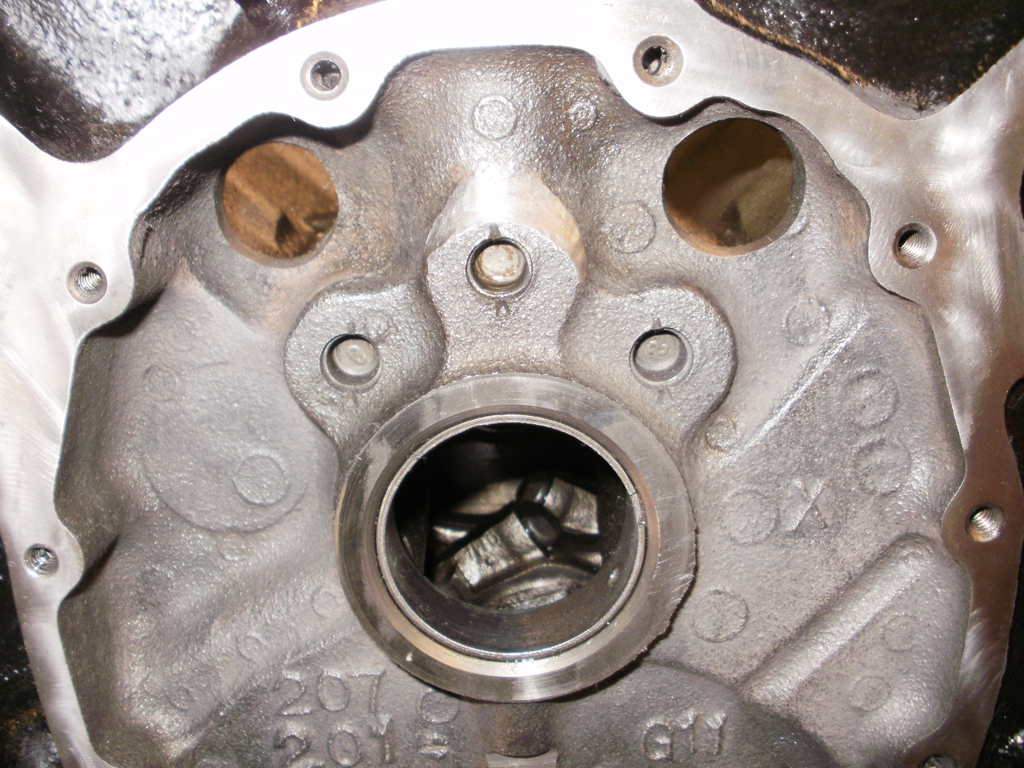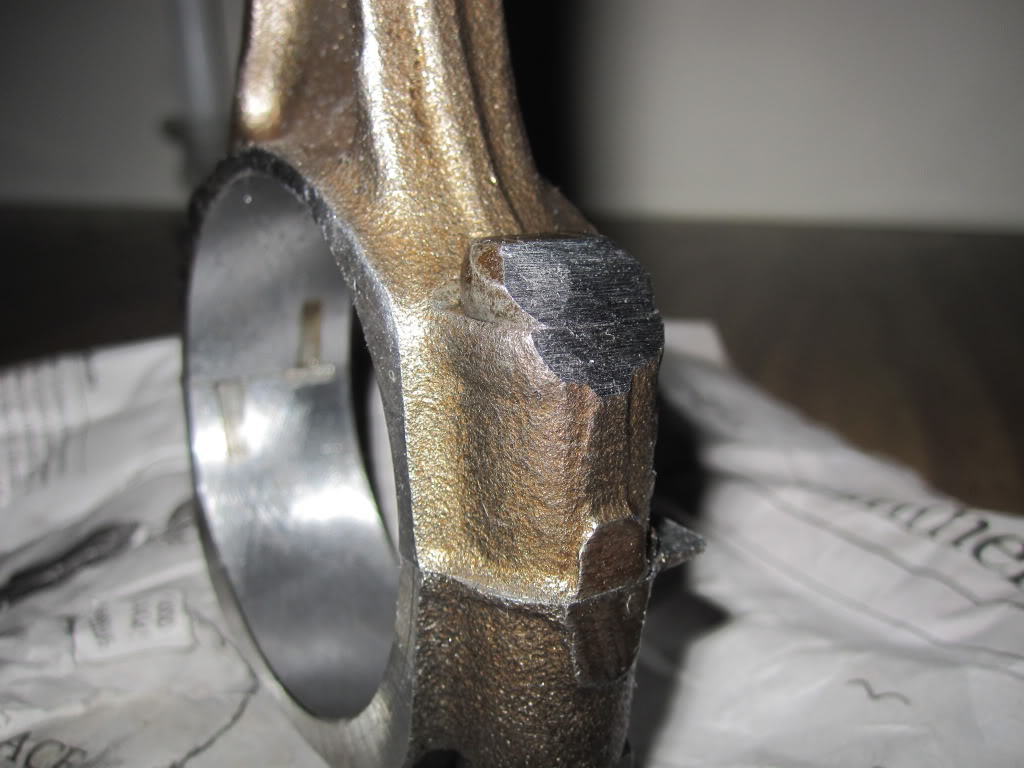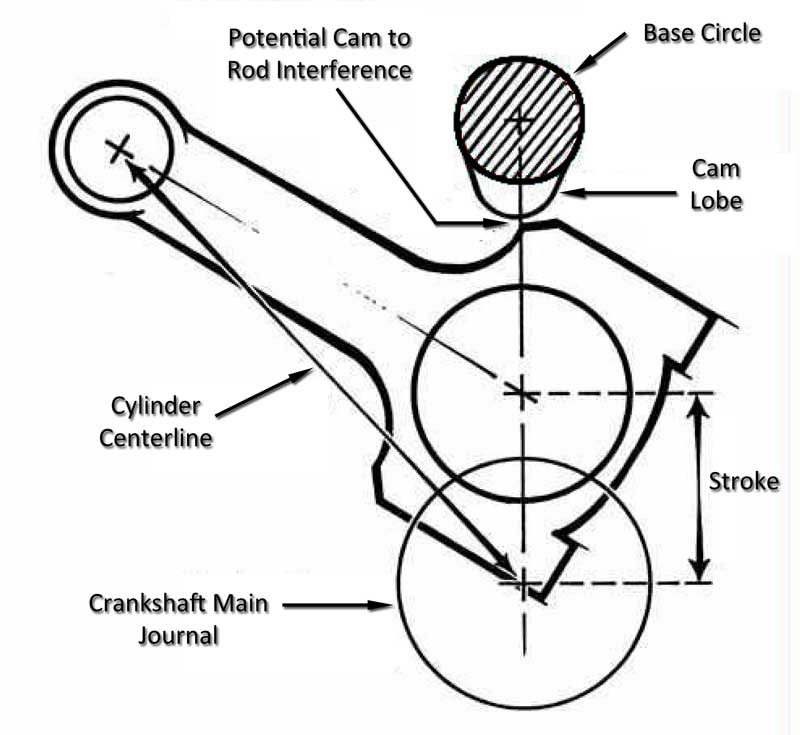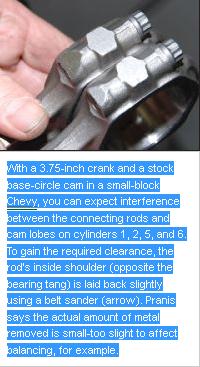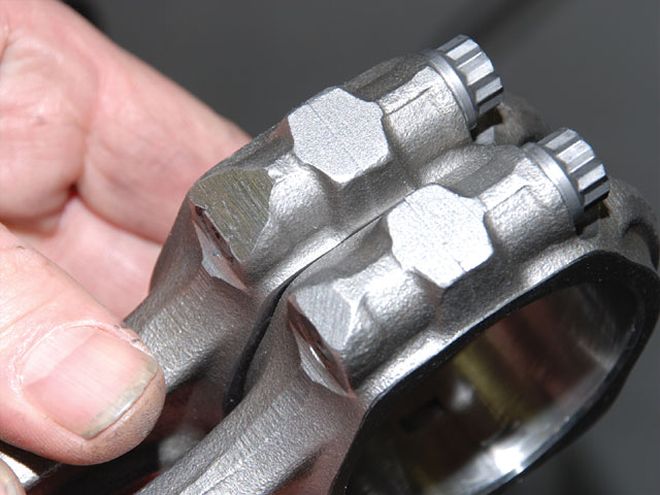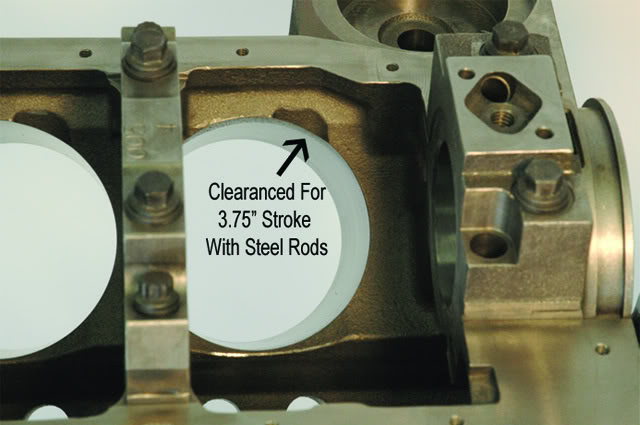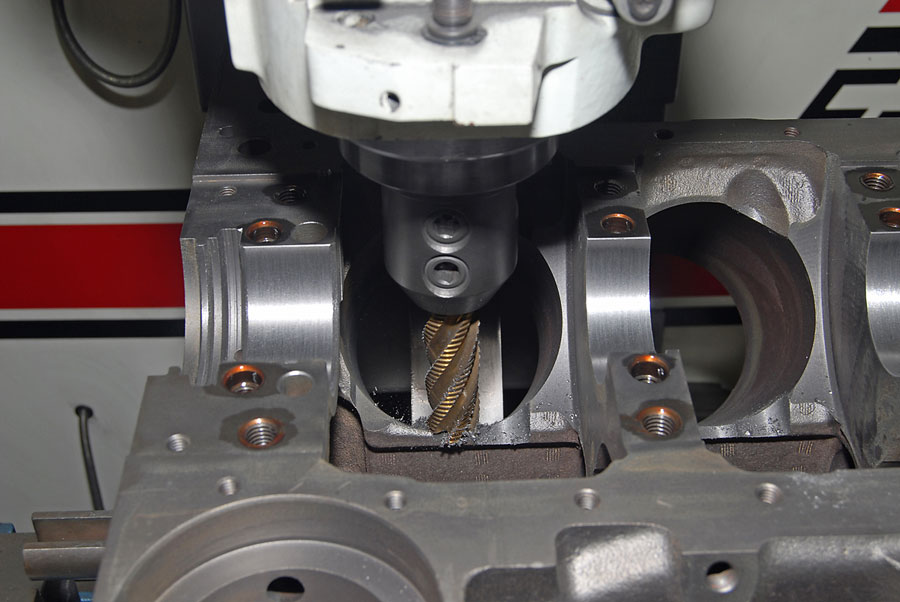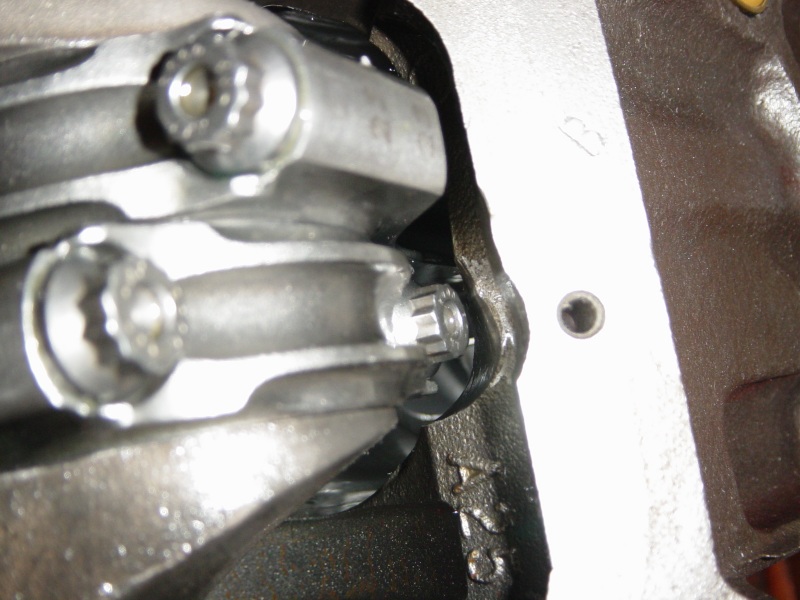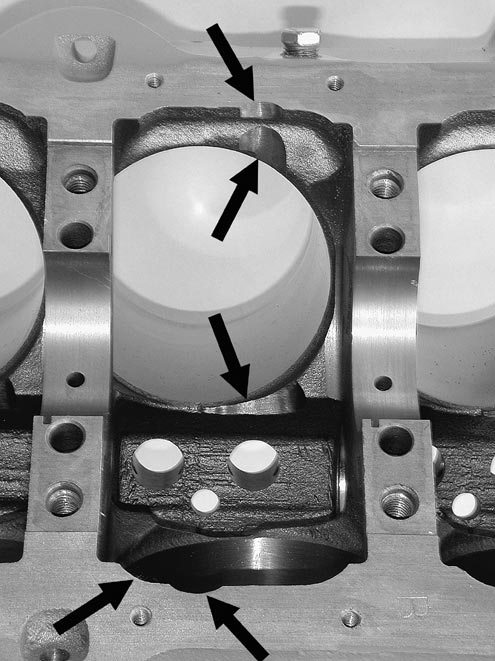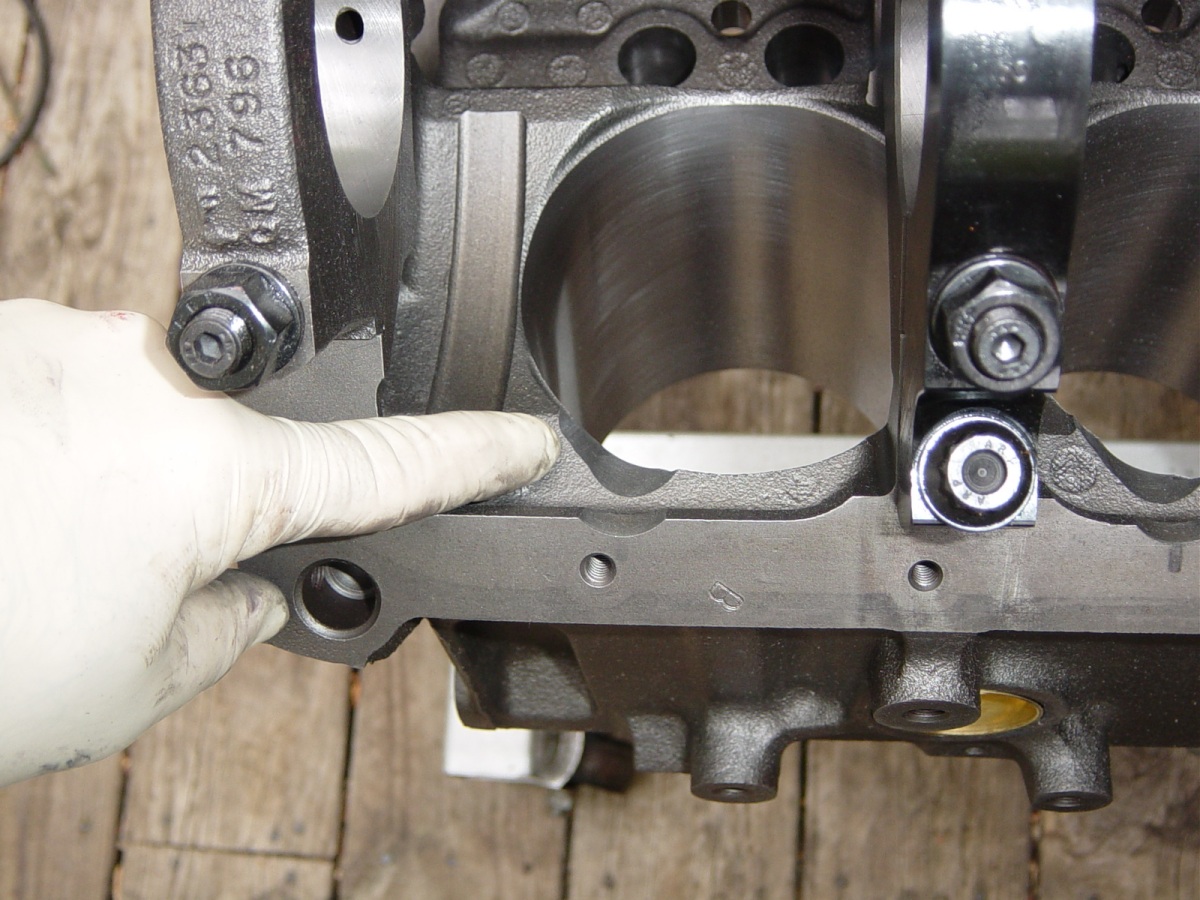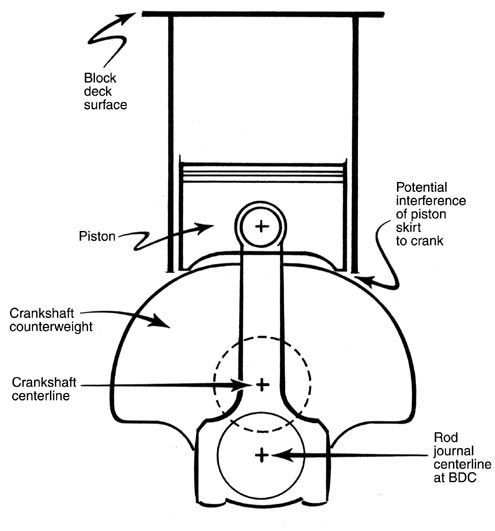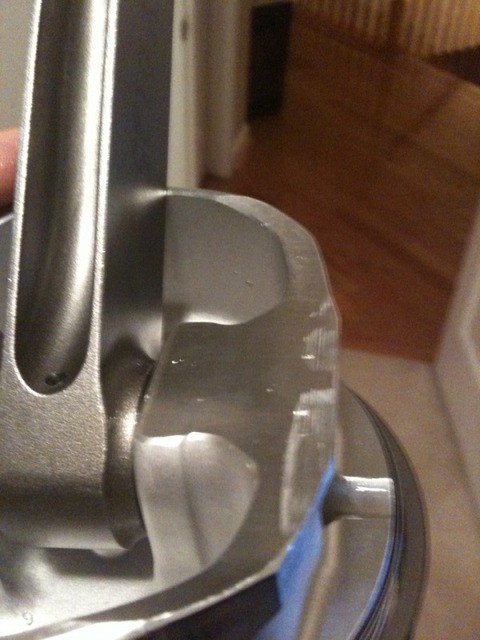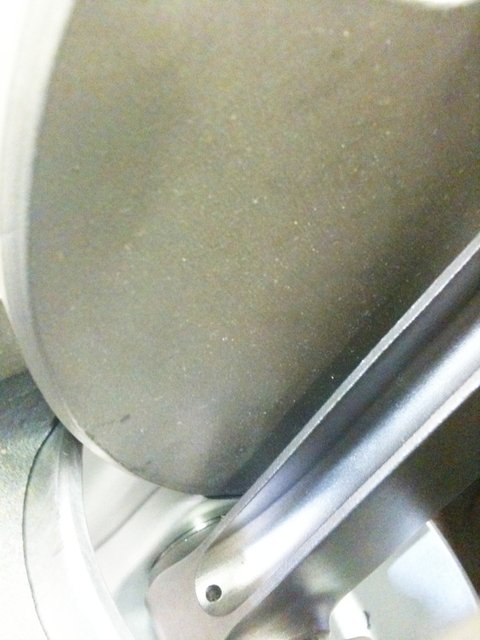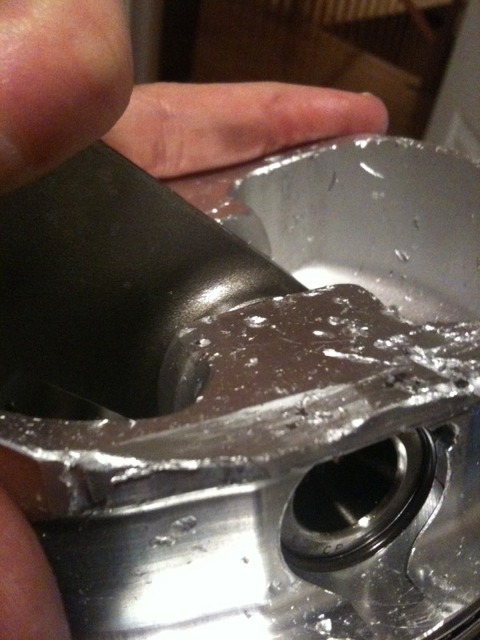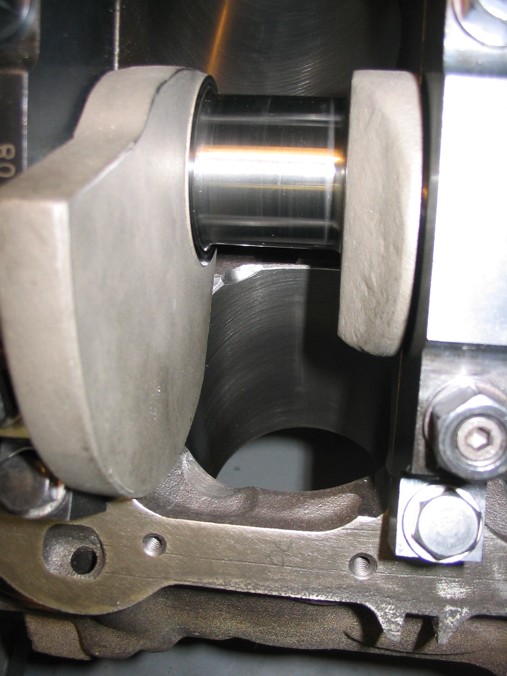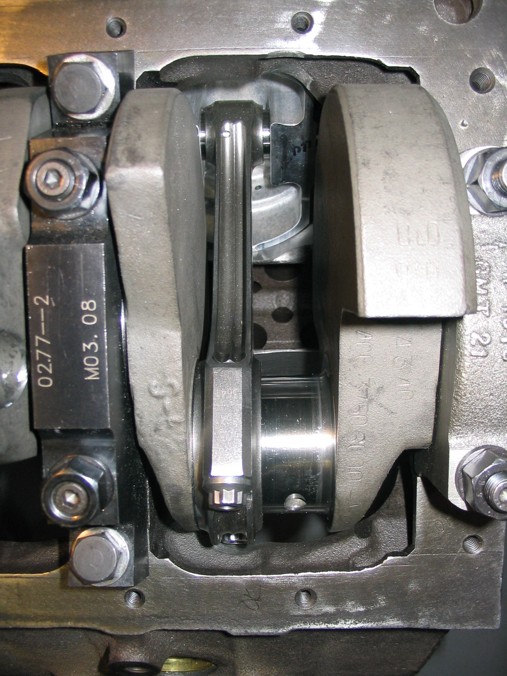this is the type of challenge/upgrade I work on for the guys all the time,
AND I'M CERTAINLY NOT SUGGESTING YOU CAN,T REACH YOUR GOAL,THRU OTHER ROUTES, BUT THAT APPROACHING THE PROBLEM LOGICALLY ITS FAIRLY EASY TO PLAN YOUR GOALS AND COURSE TO ACHIEVE THEM,Ill make some suggestions but you'll make the choices. keep in mind the cam timing, compression ratio, head flow rates,rear gearing and stall speed MUST match
- FIRST TPI Intake.(good choice)
intake comes with a new throttle body
reading thru the sub linked info in these threads will provide a huge amount of info
DEAL IN PROVEN FACTS NEVER GUESS , NEVER ASSUME
look through these threads
http://garage.grumpysperformance.co...earances-and-journal-surface.9955/#post-38385
http://garage.grumpysperformance.com/index.php?threads/clearance-issues.12072/#post-57822
http://garage.grumpysperformance.co...g-and-installing-connecting-rods-pistons.247/
notice how the rod bolts come close to the cam bearings and cam lobes,as the pistons reach top dead canter in the bores, this clearance must be individually checked and should be no less than about .060 (generally you cam use a LARGE plastic tie-wrap
https://www.amazon.com/BuyCableTies...D=41U9CtmwOuL&preST=_SY300_QL70_&dpSrc=detail
placed between the cam lobe and connecting rod bolts or connecting rod shoulder areas to check clearances as the soft tie-wrap will not damage the cam lobe while you verify clearances)you must install the timing set and index the cam correctly to get a valid clearance , as the cam lobes rotate and at some point they can be incorrectly indexed too hit the rods, while they would not if correctly timed.
why you need to verify the cam to rod bolt clearance
on some stroker applications SOME rods need to have the bolts ground for cam lobe clearance
first step.
before you start panicking and potentially wasting money and time.
would be to assemble a single piston and rod assembly without rings,
but ideally with some old bearings on the crank and connecting rod and install the cam, in the block
( indexed with a simple,dot to dot timing on the timing gear sets should be ok at this point)
move that connecting rod and piston to all 8 locations and very carefully verify clearances (remember the rod clearance bevel faces the crank counter weight and the piston valve clearances face the outer block)through the full 720 degree rotational cycle, remember the cam spins at 1/2 the crank speed so the cam lobe comes close to the rod every other rotation,
and
actually verify you DO, have or DON,T have a potential clearance problem
theres zero sense in runninbg around pulling your hair out and screaming until,
theres actually a PROVEN ISSUE too SOLVE (THERE MAY NOT BE!)
now if you find theres an issue to be solved you proceed using facts
and while your checking the cam lobe to connecting rod clearance check the connecting rod to block clearance ....yes the same minimum .060-.080 clearance is suggested
http://garage.grumpysperformance.co...earances-and-journal-surface.9955/#post-38385
generally its a minor easily done clearance job
http://www.scatcrankshafts.com/index.htm
don,t forget to verify the cam to connecting rod clearances
a cams VALVE LIFT is determined by the DISTANCE the lifter moves as the cam rotates under the lifter base as it moves from the cam lobe base circle
(the closest the lifter comes to the cams center line)
up to the cam lobes ramp to the lobes peak,
(the furthest the lifter up off or from the cams center line)
don,t forget to carefully check the piston skirt to crank counter weight clearance, it should be a MINIMUM of .080 thousands
heres some pictures taken of an engine assembly that use a crank designed for a MINIMUM of a 6.25" connecting rod that was used with a 6.135" connecting rod
you can clearly see where the piston pin boss was being hit bye the counter weights, even though the builder checked one piston and found it had .025 clearance during assembly
the result was a trashed engine with lots of damage
viewtopic.php?f=50&t=1249&p=3409&hilit=stroker#p3409
first question I'm usually asked is WHY build a 383-401, that's simple, you want to use the 350 block that came in the car to save money and make this a simple operation, the 383-401 strokers make excellent power and the increased displacement has advantages,(more total hp and a lower average rpm band) if a 350 makes 1.1 hp per cubic inch you have about 385hp, the same hp ratio in a 383 gives you about 425hp. and usually at about 300-400 rpm lower average rpm, that's easier on the valve train.
the first thing you'll need to get strait in your mind is the realistic budget you'll be willing to work with and that performance is basically the result of the power to weight ratio and HOW effectively you can get the power to the ground. keep in mind that for a street car your NOT building the engine for max peak power, your looking to build for the best average power/tq curve over the rpm range youll use most
AND THAT HAVING SLIGHTLY MORE HP THAN THE MINIMUM REQUIRED IS SMART, simply because you won,t always have the ideal tune or traction available,its silly to shoot for minimum levels yet its a waste of money to over build the engine, to levels you'll seldom use or even want, as theres always compromises in drive-ability
ok first Id point out that its silly to build anything smaller than a 383 displacement simply because you'll make significantly greater total power from a larger engine than a smaller one,COSTS for a 383 are just not that much higher than a 350, and its TOTAL POWER not horsepower per cubic inch your interested in!
next,CORRECTLY MATCHING the cylinder heads, cam and compression ratio , to the rpm range where you'll get the best results is where you'll make most of your power potential.
think it thru before buying parts, and only select those components that match your goal,by far the most common mistake is randomly selecting mis-matched parts because you "GOT A DEAL"
ok lets look at your options, to keep costs reasonable we want to use what we can from your current engine but its insane to limit yourself to parts that restrict your potential power levels severly like the current heads,intake and rear gear ratio.
viewtopic.php?f=50&t=1249&p=3409&hilit=stroker#p3409
the formula for hp is (tq x rpm/5252=hp
example
450 ft lbs of torque at 3000rpm=257hp
450 ft lbs of torque at 6000rpm=514hp
because the torque is available at that higher RPM RATE and at the higher rpm using gearing the rotational force the engine supplied can be applied faster or slower to the rear tires
if your smart your not looking to spend a huge amount of cash but you do want a reasonably quick car,
a few calculations will quickly point out that your really looking to have between 375-450 rear wheel hp, that basically translates into an engine making about 18% higher power at the flywheel, so lets assume or goal is a 450-500 hp engine, now your basic 383 will be correctly designed and matched to a rear gear ratio in the 3.73-4.11 rear gear so you'll maximize the area in the torque curve that can give the best results, the 2800-6300rpm band. so that's where we NEED TOO concentrate our efforts. this should point out the stall speed of about 2800-3000rpm is ideal in this application to match your needs
a 383 with its 3.75" stroke and reasonably street-able cam will be using a cam with between ABOUT 225-235 duration at .050 lift with a matching compression ratio in the 10:1-10.5:1 cpr range
look at this chart, it shows the ideal duration for best results at different rpm bands, well want the MINIMUM DURATION that will supply our needs that's going to be in the 220-230 range for street use,while the 230-235 range would be about ideal for power.but you'll loose street-ability.
we quickly find that duration will match to a 10:1-10.5:1 cpr if we want to use pump gas.
why do I usually suggest a hydraulic roller cam?
read this
http://www.idavette.net/hib/camcon.htm
ok,now the CYLINDER HEADS and intake NEED to supply that RPM RANGE and DISPLACEMENT, youll want a set of heads that flow about 230cfm AT .500 lift at the MINIMUM and 250-270cfm is FAR better,to easily match that requirement.
http://www.jegs.com/webapp/wcs/stores/servlet/product2_10001_10002_760699_-1
http://airflowresearch.com/eliminator.php
http://www.compcams.com/Community/Articles/Details.asp?ID=1737510521
http://store.summitracing.com/partdetail.asp?autofilter=1&part=TFS-32400007&N=700+304524+115&autoview=sku
those heads and that compression ratio, and cams Ill suggest will match the 3000rpm stall speed but youll need a 3.54:1-3.73:1 rear gear ratio to match.
cams like this
http://www.cranecams.com/?show=browseParts&action=partSpec&partNumber=119661&lvl=2&prt=5
heres the SMALL BASE CAM I USE IN MY 383
NOTICE it has a .900 base circle
your cams lift is the result of the lifter movement distance from the cams base circle, where the valves seated to the point where its fully up on the nose of the cam lobe where the valves at full lift.
example
lets say in this case we compare two imaginary cams
a standard cams base circle is 1.125" and
your cams running on a .900 base circle
both cams have a .560 valve lift and run with 1.5:1 rockers
so both cams will need to move the lifter .374"
that means the standard cam lobe will be 1.125"+.374" or 1.499" from the cams base to the cam lobe nose
that means the small base cam lobe will be .900"+.374" or 1.274" from the cams base to the cam lobe nose
which is significantly smaller
a small base circle gives more clearance because your cam lobe lift is the difference between the base circle and the lobe nose, lets assume a .500 lift on a Chevy sb
they normally use a 1.5 ratio rocker so the cam lobe needs to be .3334 tall , so with a standard base circle the lobe nose swings in a circle that's about 1.766 in diam.
(
a small base circle cam like my crane with its .900 diam. with the same lobe would only spin in a circle that's about 1.568 in diam. giving about 0.100 inches MORE CLEARANCE TO THE POTENTIAL ROD/CAM CONTACT AREA
http://www.cranecams.com/?show=browseParts&action=partSpec&partNumber=119661&lvl=2&prt=5
this makes slightly better PEAK power, but was less street-able
http://www.crower.com/misc/cam_spec/cam_finder.php?part_num=00471&x=20&y=9
stroker kits
http://www.speedomotive.com/ps-522-85-383cid-mighty-mouse-budget-all-forged-stroker-kit.aspx
http://www.speedomotive.com/ps-525-85-391cid-all-forged-stroker-kit.aspx
installing a longer 3.75 stroke crank assembly
Ive built dozens of 383 and 396 sbc engines and the clearancing can be done BY YOUR OWN HANDS with a standard HAND HELD drill and a few CARBIDE BURRS OR GRIND STONES in that drill in well under two hours if you take your time and total expence even if you need to buy that drill and burrs will be well under $50 total
place you old bearings in the block an place the crank in those bearings after coating them with axle grease
slowly rotate the crank and grind a minimum of .060 clearance anywhere the counter weights might touch the block and try NOT to grind more than about .070 any place it touches the block (use a JUMBO size paper clip as a gauge if you don,t have feeler gauges)
next assemble two connecting rods and pistons, one connecting rod and piston for the left one connecting rod and piston for the right, use old bearings coated with axle grease and no rings on the pistons, assemble them to the crank and grind anyplace the rods touch the block, grind minimum of .060 clearance and try NOT to grind more than about .070 any place the rods touche the block (use a LARGE size paper clip as a gauge if you don,t have feeler gauges)move them to the next journal and repeat until all 4 journals and 8 connecting rods clear. now assemble all eight rods and pistons without rings and install them in their correct locations and recheck everything carefully.
next install the cam and index it correctly with the timing chain/gears, rotate the engine slowly and look for clearance issues, between the cam and rods/rod bolts ,you'll need to use a small base cam if there are major clearance issues but in most cases if your cams lift and duration is under about 230 at .05 and .500 lift there should be minor if any clearance issues, usually the outside edge of a rod bolt head is the only area needing a touch up.
once everything clears, wash all the parts VERY CAREFULLY ,TWICE and re-oil then send out to be balanced now you might ask why do that! well, first you'll know its done correctly, and that a correctly built 383 will have a very significant hp and torque advantage over any similar 327 or 350
how much power I'll get.
that of course depends on the combo, cpr, cam,ETC. but you can assume about a 40hp/40 ft lbs increase over a similarly built 350
some of the major factors in your engines potential power, is the volumetric efficiency (how efficiently you fill and empty the cylinders) and the octane of the fuel used, compression ratio and detonation limits,
With detonation, prevention the main factors are
Ignition timing
Quench
FUEL OCTANE
DCR
and cylinder heat level
you�ll be fairly safe if you stay under
8.5:1 dcr at 170f degrees
8.25 dcr at 180f degrees
7.8:1 dcr at 210f degrees
and keep the quench in the .036-.043 range
need a few pictures?
this may help
the common areas are the area near the block oil pan rail where the rod bolts touch
and the lower inner cylinder walls and where the cam lobes touch the rod bolts upper shoulder on some types of rods, now you can,t grind on the cam, but you can grind the edge of the rod bolt and you can use a small base circle cam to give greater clearances
obvious interference
QUENCH??
http://www.100megsfree4.com/dictionary/car-dicq.htm
http://www.autobodytoolmart.com/pc-1476 ... 14tin.aspx
quench area:
A zone in the combustion chamber where the piston at top dead center is very close to the cylinder head. Because the piston and cylinder head is cooler than the unburned part of the fuel-air mixture (i.e., end gas), they pull the heat from the end gas. Because the end gas is now cooler, detonation is quenched or reduced. However, the process does form unburned hydrocarbons.
SQUISH
An area in the combustion chamber of some engines where the piston squishes or squeezes part of the fuel-air mixture at the end of the compression stroke. As the piston approaches top dead center, the mixture is pushed out of the squish area and this promotes turbulence, further mixing of the fuel-air mixture and more efficient combustion
run less than about .035 thousands and at high rpm levels the pistons might hit the cylinder heads, run more than about .044 thousands the QUENCH effect of forcing the fuel air mix to the center of the cylinder from the cylinders edge area looses both speed and effectiveness, remember the quench area must be so tight that virtually all the fuel/air mix is forced (squished) into the center area and none is allowed to burn until its squirted into the burn area increasing turbulence and burn efficiency
in theory the much better quench, combined with the shorter more compact area the flame front needs to cover and the far higher turbulence combine to allow more of the pressure to build AFTER the crank passes TDC on the end of compression and beginning of the power stroke
its mostly an advantage in that you get a more even and FASTER burn in the cylinder and less chance of detonation, simply because both the lower time and faster pressure curves favor the ignition flame front vs detonation
look, it takes approximately 40 thousands of a second for the flame from the ignition to cross a 4.25" bore,at low rpms and still takes about 15 milliseconds at high RPM due to the much faster movement of the compressed fuel air mix in the cylinders, lets look at what that means
if the Chevy plug is located 4/5ths of the way to one side that's a time of about 32 thousands for the pressure to build as the flame travels 3.4" in the Chevy but in a compact combustion chamber it could only take the cylinder flame front less than 10-20 thousands of a second to travel across the combustion chamber for a complete burn at low rpms, this of course speeds up as the swirl and turbulence increase with increased engine RPMs but the ratios stay similar. this results in more usable energy WORKING on the piston AFTER IT PASSES TOP DEAD CENTER ON THE POWER STROKE. BUT MODERN WEDGE combustion chambers use increased QUENCH to speed the flame front and lower the burn time combined with a smaller combustion chambers.
the difference may be easier to grasp if you think of the quench area as a significant part of the total combustion chamber volume,that's forcing its potential fuel/air mix into the central combustion chamber as a jet of highly compressed F/A mix, like the differance between lighting a cup of gasoline by simply placing it next to a camp fire vs throwing it violently into a camp fire.
I get asked frequently what will be the (best) combo,well, first thing, Id point out, and that needs to be addressed is there IS NO BEST COMBO, theres only EXCELLENT combos for YOUR application, and YOUR APPLICATION won,t be, exactly the same as everyone elses,or lets say very rarely will be exactly the same as the guy next to you with a similar car.
heres a few examples of threads or links with lots of sub-links and info
http://www.rustpuppy.org/chp/Welcome.html
http://www.compcams.com/Community/Articles/Details.asp?ID=1737510521
http://www.chevytalk.org/fusionbb/showtopic.php?tid/131229/
http://www.digitalcorvettes.com/forums/showthread.php?t=83410
http://www.digitalcorvettes.com/forums/showthread.php?t=81956
the MAJOR factors
DISPLACEMENT
basically one thats simple, the bigger the better within reasonable limits imposed by budgets and geometry/clearances, simply because if your building a SBC or SIMILAR engine and you make lets say 1.2hp per cubic inch, a 327-350 will make a significantly lower level of usable power than a 383-396 SBC
WHILE your planing your combos parts selection, be aware that IF your going to be driving the car far more frequently in the lower thru upper mid rpm ranges (2500rpm-5500rpm) on the street than you would with a racer car,combo, you'll be miserable building a combo for max peak hp alone,(where your more likely to concentrate on the 4000rpm-6500rpm plus band with a pure race car,) because you'll rarely be taking the engine into its peak rpm levels, on the street, you'll be far better off building a combo for killer mid and upper mid rpm torque on the street. if you concentrate your efforts into building a wide flat max torque curve in the 2500rpm-5500rpm band and having peak hp fall near 6000rpm you can have an exceptionally responsive and fast car
COMPRESSION RATIO
if you play with differant combos for awhile youll quickly find that as the cpr goes up so does the torque tend to increase, but your limited by the octane rating of the fuel, the heat levels and detonation that tends to increase along with the increased compression.
heads and combustion chamber sizes vary a great deal, your REQUIRED to figure all the factors in your combo out carefully
you'll generally gain about 3% from a point of compression increase, but the return tends to get lower as the CPR increases, so youll get slightly larger fraction of a percentage increase from a 8:1-9:1 increase than a 11:1-12:1 increase and after about 12:1 the gains fall of faster if GAS is the fuel.
with typical pump gas that limits you to about 10:1-11:1 STATIC COMPRESSION,in most cases. dynamic compression ratio should not exceed about 8:1 in most pump gas combos
HEAD FLOW
your port flow and cross sectional area, WILL effect the power the engine combo can potentially make, theres a rough guide to relate head port flow rates to potential power levels
stock head rarely flow more than about 210cfm, even vortec heads rarely exceed 230 cfm, the better aftermarket heads can exceed 270 cfm, but keep in mind head flow rates at lifts greater than your cam lift ALLOW the ports to flow are CLOSE TOO MEANINGLESS IN YOUR COMBO, and the valve passes thru the lower lifts TWICE but only reaches PEAK lift once, its best to concentrate on the flow rates at .300,.400,.500, where the major flow rates occur that effect your power in a street driven cars cam and head selection.
generally the best results will be with heads that flow OVER 240CFM at .500 lift, but matching the other components in the combo is critical.
http://users.erols.com/srweiss/tablehdc.htm
http://www.malcams.com/legacy/misc/headflow.htm
http://purplesagetradingpost.com/sumner/techinfo/heads1.html
http://www.rbracing-rsr.com/runnertorquecalc.html
CLEARANCES/LIMITATIONS
your engine has factors that your forced to work with.
the parts you sellect for a basically hopped up SBC will limit your PISTON SPEEDS to between 4000FPS and 4500FPS, MAX.
your CAM timing and displacement and compression ratio, are intracantly linked,and will determine the RPM range the engine and power curve.
HYDROLIC LIFTERS will limit your peak power to below 6500rpm, and in most cases below 6300rpm.
SOLID LIFTERS will REQUIRE changes in the software that controls any MPFI that uses KNOCK SENSORS
SPRING/BIND,ROCKER RATIOS,PISTON TO VALVE,ETC.
you'll have limitations,due to physical clearances, you obviously MUST keep moving parts from binding or impacting and you'll need access to parts like spark plugs
EXHAUST
IDEALLY you'll install a tuned exhaust that EFFECTIVELY scavenges the cylinders in the rpm range your engine operates in.
significant restrictions in the exhaust system WILL reduce power potential, but once the peak exhaust pressure after the header collectors is limited to UNDER about 1PSI you'll generally have a decent exhaust,but its selection a decent exhaust that SCAVENGES the cylinders effectively
the LENGTH and DIAM. of the collector and primary exhaust pipes on the headers you select , and the restriction past the collectors WILL effect the power curve. on most SBC 302-350,and some 383 engine combos the 1 5/8" long tube headers are about ideal, on some 383-427 engine combos the 1 3/4" have advantages but the length of the primary and collectors WILL effect the results.
CAMS
your CAM SELECTION IS CRITICAL TO SUCCESS
AND yes a ROLLER WILL generally out perform a flat tappet cam.
but its a trade off in value, too upgrade the earlier engines due the the significantly higher costs of the roller cam components in the earlier non-roller blocks, and the fact that hydraulic cams(flat tappet OR roller) generally have valve control issues at or below about 6500rpm
on most EFI C-4 corvettes it requires a compromise,
http://www.digitalcorvettes.com/forums/showthread.php?t=81799
AS A ROUGH GUIDE
cams in the 210 intake duration range work well as a boost over stock
cams in the 220 intake duration range work well as a boost over hot street
cams in the 230 intake duration range work well as a boost over hot street/strip
cams in the 240 intake duration range or up work well as a race engine combo.
but in all cases the compression,ratio, head & exhaust flow and rear gearing and stall must match the combo.
http://www.digitalcorvettes.com/forums/showthread.php?t=85898
http://www.digitalcorvettes.com/forums/showthread.php?t=84157
read this
http://www.idavette.net/hib/camcon.htm
http://airflowresearch.com/hydra_rev.php
ROLLER ROCKERS AND 1.6:1 RATIO upgrade
roller rockers reduce friction & heat, they generally have a more precise ratio than factory stamped rockers and can generally increase power 10-20hp due to the more precise ratio and lower friction.
swapping to a 1.6:1 ratio from the stock 1.5:1 ratio, USUALLY helps on the milder cams,because it increase lift at the valve,and the rate the valve accelerates it also tends to make valve control at peak rpms slightly more difficult. roller rockers come in two common stud sizes, 3/8" and 7/16" dia. naturally you need to use the size matching your head studs, and the use of a rocker stud girdle is recommended on roller cam applications where the spring pressures are higher or where rpms over about 6500rpm are common
DRIVE TRAIN
your CONVERTER STALL speed, and rear gear ratio, and transmission shift points, have a HUGE effect on the average RPM range your cars engine operates in, the cars drive ability and how effectively you can use the engine power. this is often overlooked build a killer combo that makes 500hp at 7500rpm and stick it in a car with a 2.57 rear gear and a trans that shifts at 5500rpm and you've created an expensive DOG that's probably miserable to drive.
since the higher average rpms, increase the power potential, and the cams necessary to maximize the performance won,t run well with out increasing the converter speed, you'll quickly find a 2500rpm-3200rpm converter can be a huge help, but must be matched to a 3.54-3.73:1 rear gear to maximize the results. remember you may be limited to under 6300rpm or so with hydraulic lifters, and even with a 3.73:1 rear gear you can reach excessive speeds with an overdrive trans
http://www.digitalcorvettes.com/forums/showthread.php?t=64055&highlight=gearing
http://www.digitalcorvettes.com/forums/showthread.php?t=86932
QUENCH/SWIRL/TUMBLE
your intake, heads and several other factors will influence the results
READ THESE
http://www.digitalcorvettes.com/forums/showthread.php?t=86327&highlight=squish
http://www.gofastnews.com/board/technical-articles/96-turbulence-combustion-dynamics.html
http://www.gofastnews.com/board/technical-articles/169-cylinder-turbulance-combustion-dynamics.html
http://www.gofastnews.com/board/technical-articles/216-turbulance-combustion-dynamics-part-3-a.html
INTAKES
the stock crossfire flows barely 190cfm, the stock TPI intake barely 210cfm.
it will hardly boost your hp potential to install heads and other components that flow 250 plus CFM that's necessary to make decent power levels if you stick to the stock intakes that were designed MOSTLY for good off idle thru 4000rpm torque and good mileage, and try to use them on the better components.
if your looking to boost the power YOUR GOING TO BE REQUIRED to modify or replace your current intake, theres dozens of options, but if you don,t do anything the restrictive stock intakes are going to be a HUGE restriction once you try to exceed stock power levels by a significant margin
MINIRAM
STEALTH RAM
SUPER RAM.
EDELBROCK,
TPIS
ASM
CUSTOM INTAKES
and
EXTENSIVE PORTING all are OPTIONS
(some have far more potential and/or problems than others)
AIR/FUEL RATIOS
youll get the best MILEAGE and lowest EMISSIONS at about a 14.7:1 fuel /air ratio, youll get the best power at about a 12.5:1-12.7:1 fuel/air ratio,
your HP will depend on a constant and well regulated flow of that precise well regulated mix and as the hp increases the size of the injectors and durration of the pulse width will need to keep pace with the increased air flow rates
THERE'S A CALCULATOR at the bottom of this LINK
http://www.rceng.com/technical.aspx
IGNITIONS
THERE'S DOZENS ON THE MARKET, MSD is an industry leader, but CRANE, and several others have decent ignitions, even your stock ignition can be improved, but don,t get crazy you can spend huge amounts and not significantly improve on some of the common mid range price systems
MISC.
when selecting heads,headers,intakes ETC.
take the time and effort too CAREFULLY research the compatibility,
some heads have spark plug access that's nearly impossible with some headers, some intakes won,t allow you to use some distributors or ignitions
some heads have ports that miss align or won,t fit with some intakes
some rockers won,t fit some heads
some valve covers won,t clear some valve trains
most cams REQUIRE matched springs
flat tappet cams REQUIRE new lifters
some converters won,t work with some transmissions
some rear gear ratios won,t fit some rear differentials
http://www.digitalcorvettes.com/forums/showthread.php?t=81954
YOUR CAM TIMING,COMPRESSION AND REAR GEAR RATIO MUST MATCH

